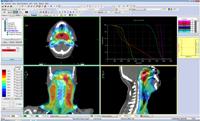
July 21, 2011 – Among the many new features of Monaco 3.0, dynamic conformal arc (DCA) therapy provides clinicians with a simple way to deliver highly conformal stereotactic plans by using the multi-leaf collimator (MLC) to dynamically conform around a target as the treatment beam rotates around the patient. DCA recently received 510(k) clearance for Monaco from the U.S. Food and Drug Administration (FDA).
"DCA can be used to render more conformal plans by creating multiple arcs in a non-coplanar fashion – in such a way that the geometry of each arc minimizes the dose to the adjacent organs during the gantry rotation," says Todd Powell, executive vice president, Elekta Software. "When this technique is used in conjunction with micro-MLCs – such as the new Apex MLC [not yet available in the United States], which is now supported in Monaco 3.0 – it can yield very conformal plans and is much easier in terms of quality assurance measurements."
DCA is particularly well-suited for stereotactic treatments because it eliminates the need to modulate the typically higher doses per fraction in stereotactic therapy. DCA's benefit, therefore, is fewer monitor units and reduced treatment time compared with other delivery methods.
"With DCA, clinicians have the option to obtain a comparably conformal plan with approximately half the treatment time and reduced scatter dose," Powell adds.
Streamlining the stereotactic workflow is a major goal of Monaco 3.0, which includes:
-Apex micro-MLC: 2.5 mm nominal leaf resolution, 12 x 14 cm field size
-Planning with multiple isocenters: Enables same-fraction, single-plan stereotactic treatment of, e.g., multiple brain mets, multiple brain lesions
-Plan review and summation for any number of plans
-Summed dose from multiple plans can be saved into a single plan
-Sensitivity analysis data table integrated into prescription
-Workflow-enhancing changes to graphical user interface
-New dose analysis tools
For more information: www.elekta.com


 July 31, 2024
July 31, 2024 








